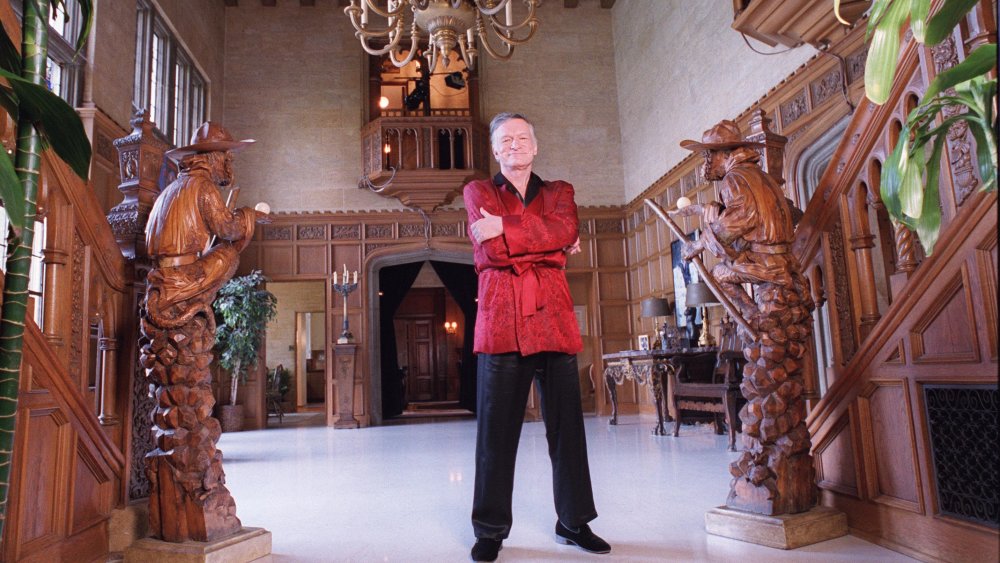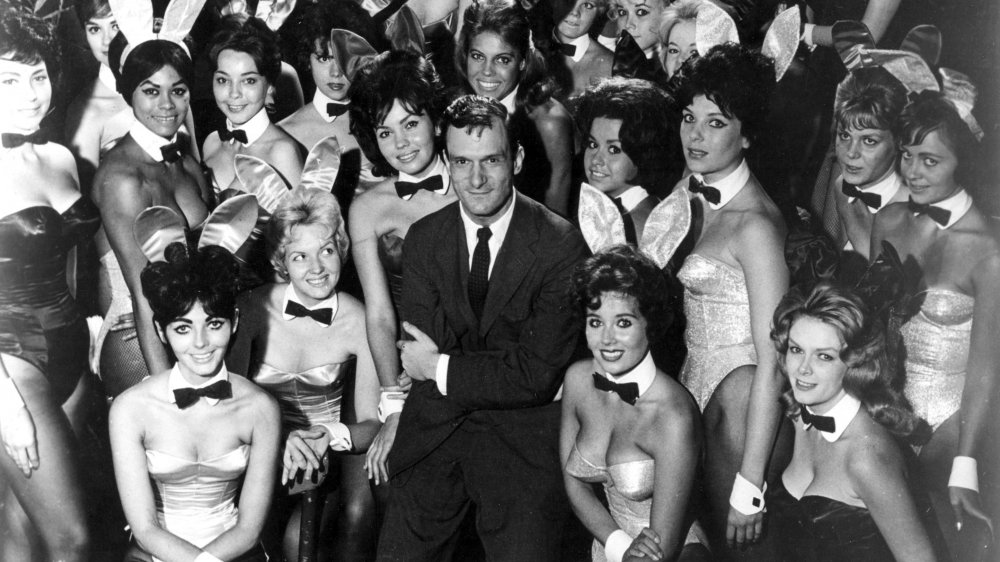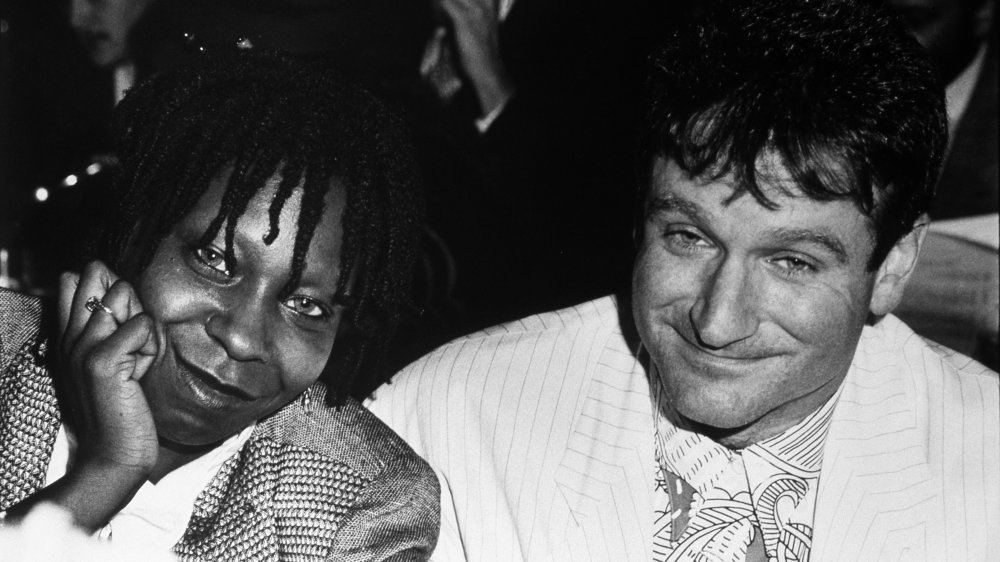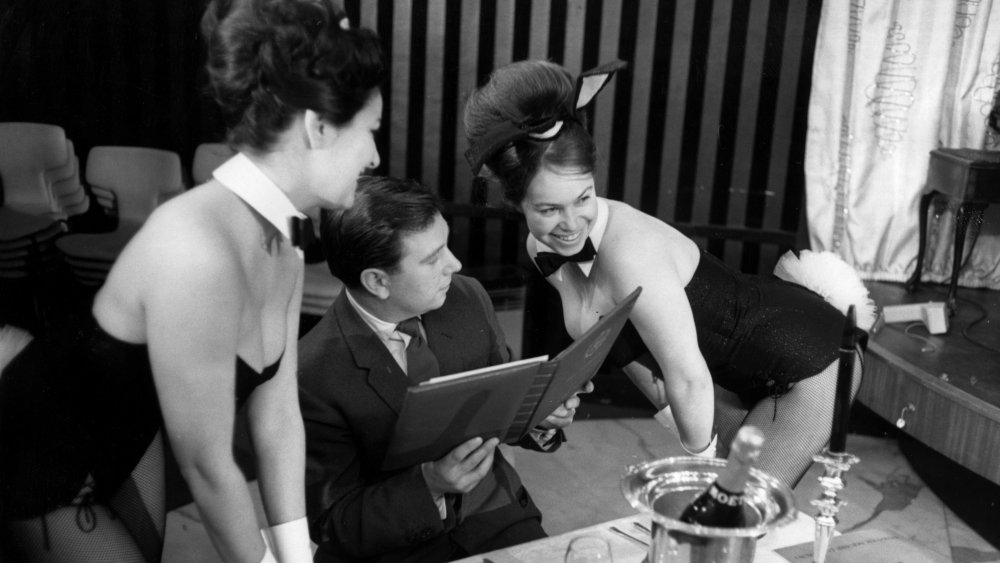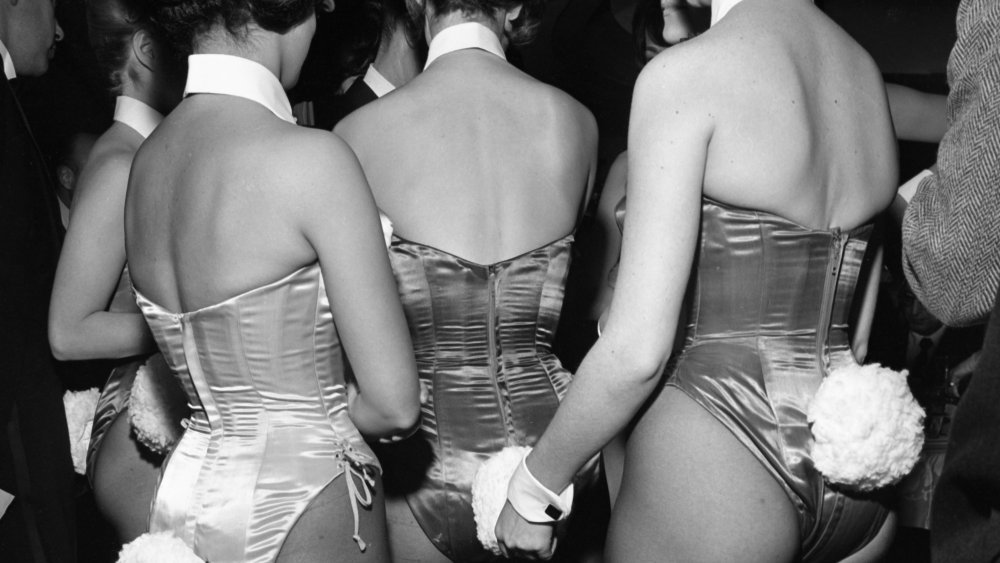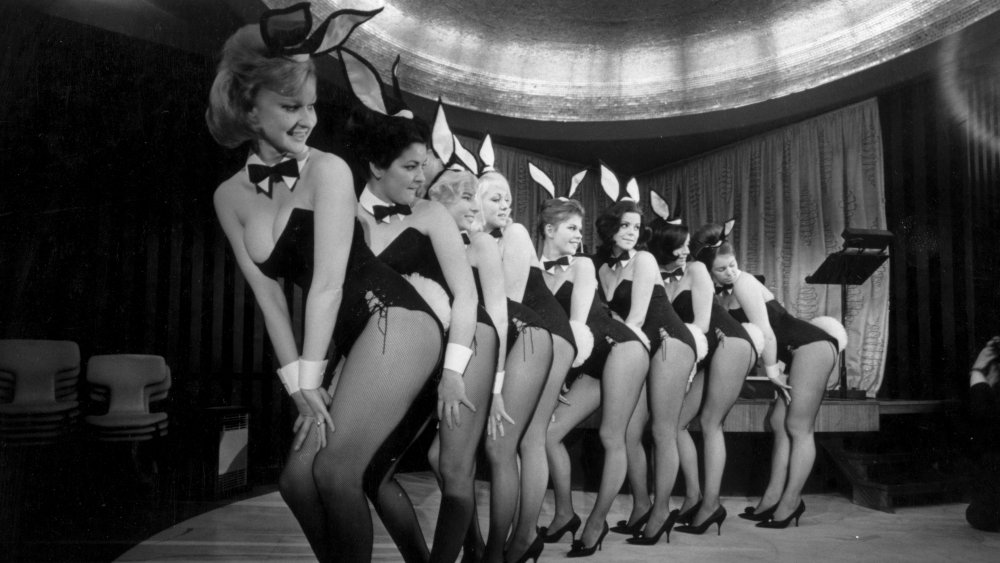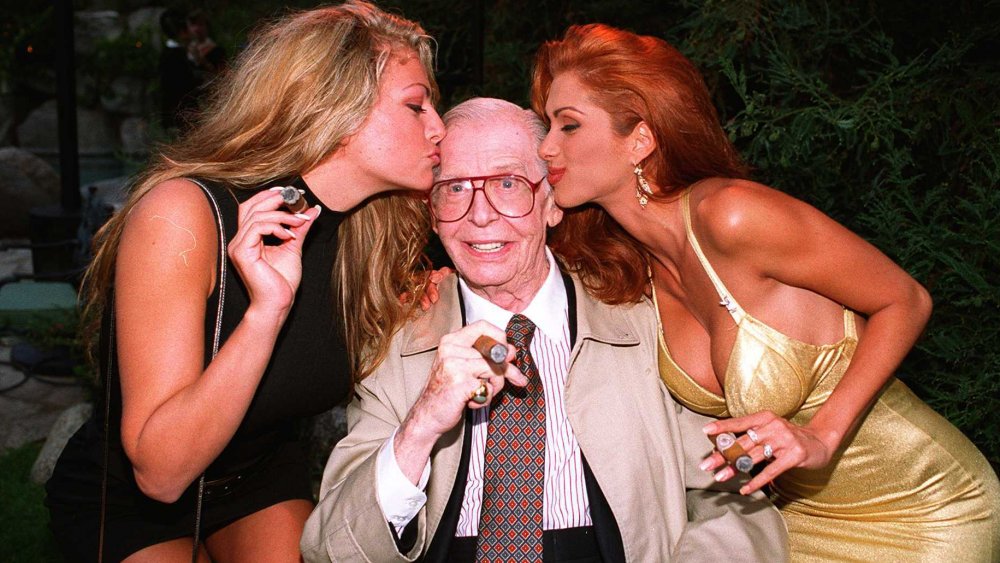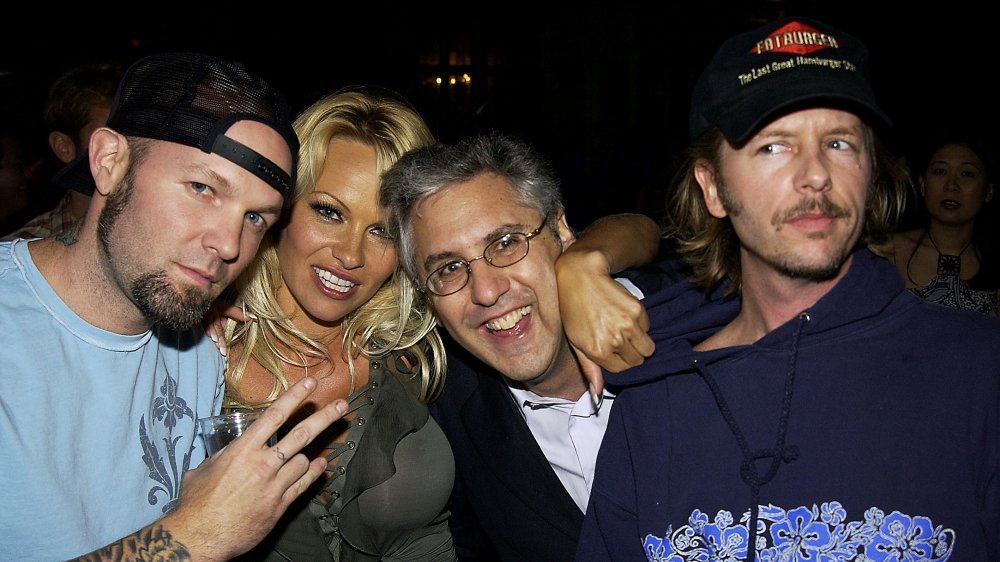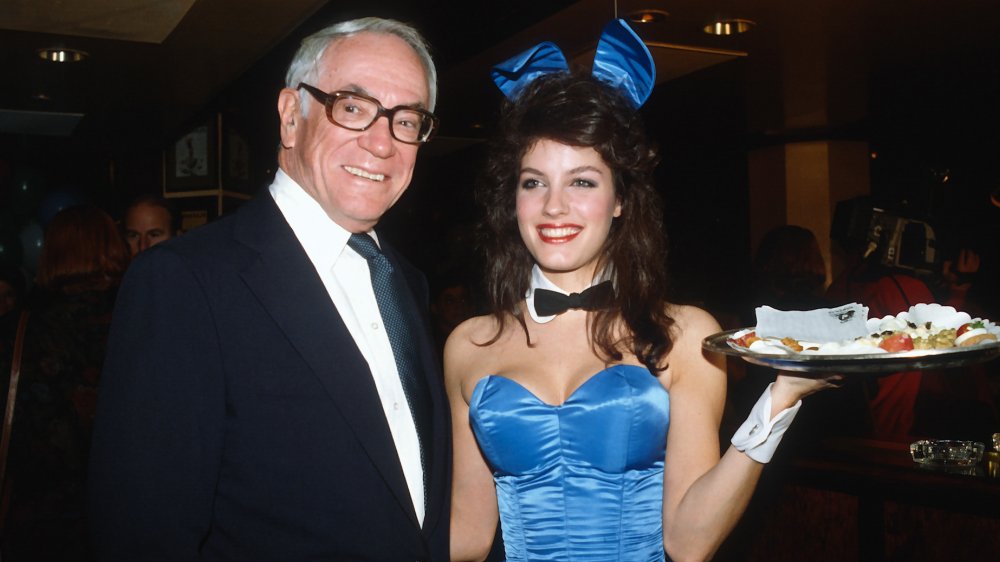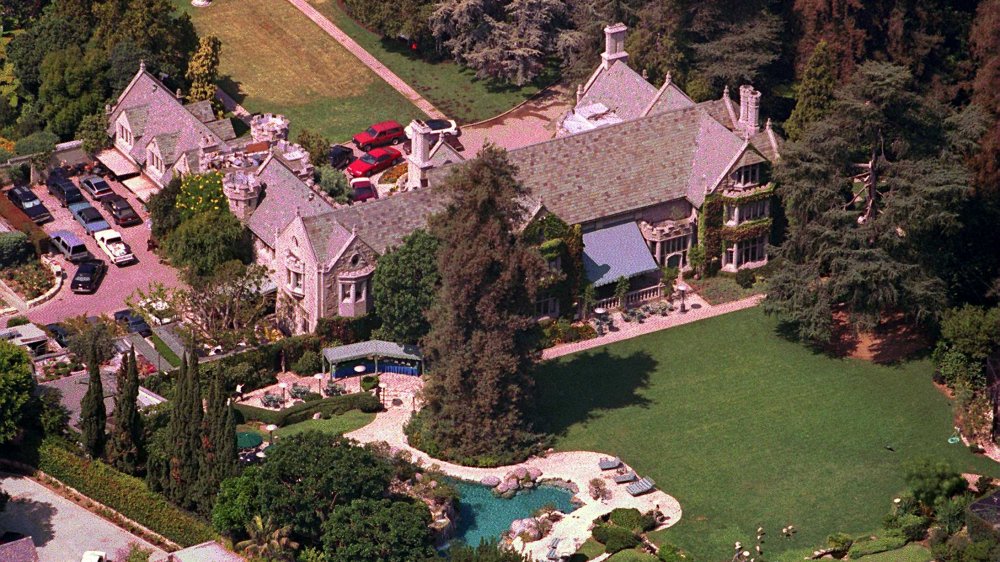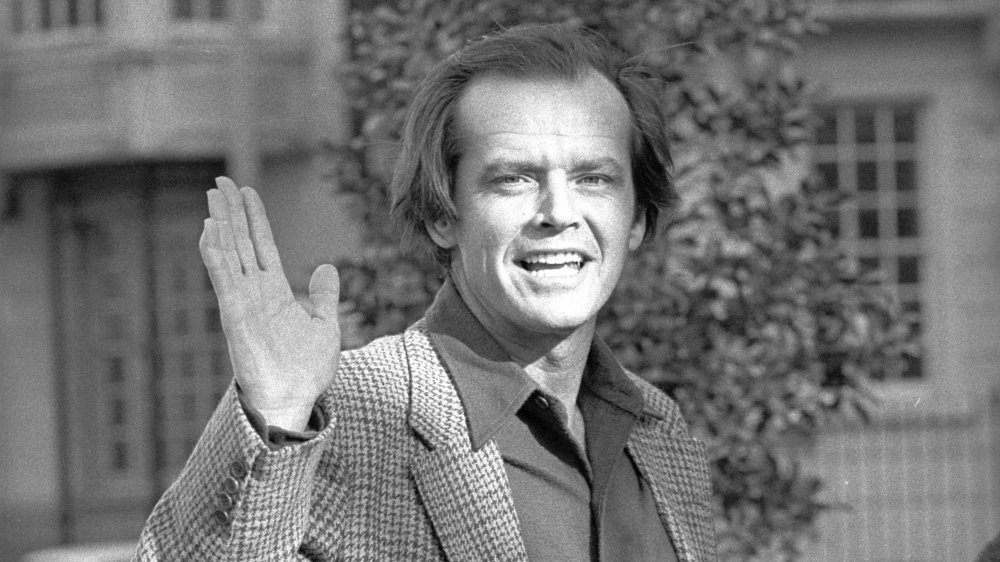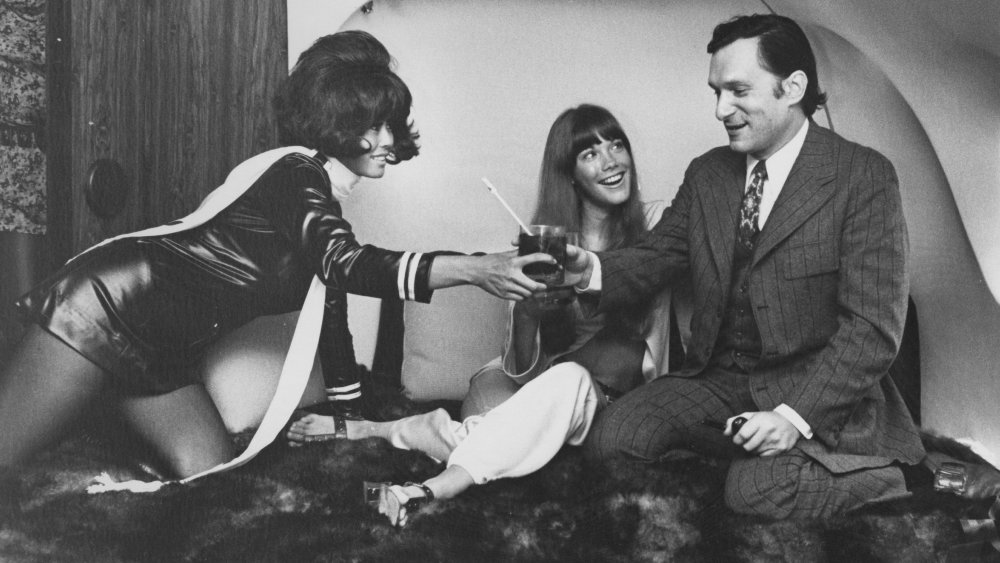What It Was Like Living In The Playboy Mansion
There's no denying that Playboy is one of the most iconic publications in American history. Its logo, the Playboy bunny, is instantly recognizable, and while the magazine is mostly known for its pictures, it has also been home to some of the world's most prolific writers, from Haruki Murakami to even Margaret Atwood.
Another aspect of this legendary brand? The infamous yet highly secretive Playboy Mansion. Once the home of the founder and editor-in-chief, the late Hugh Hefner, the mansion was a stark contrast to what Hef wrote in his inaugural letter in the first issue of Playboy (via The New York Times): "We enjoy mixing up cocktails and an hors d'oeuvre or two, putting a little mood music on the phonograph and inviting in a female acquaintance for a quiet discussion on Picasso, Nietzsche, jazz, [and] sex."
While Hefner's words may have rung true in the early years of his empire, the buzz over what exactly was known to happen at the Playboy Mansion was bacchanalian — a constantly rotating variety of "Bunnies," celebrities, booze, and, of course, sex. As The New York Times put it so succinctly in 2017, "Everyone in Hollywood has a Playboy Mansion story. Many are unprintable." Let's dig further and find out what living in the Playboy Mansion was like.
The girls at the Playboy Mansion were seen as disposable
Launched in 1953 with Marilyn Monroe on its cover, Playboy was an instant success. According to The New York Times, all 51,000 copies made sold out. "After five years, the magazine's annual profit was $4 million," and as the company grew, so did its various businesses. In 1960, the first Playboy Club was launched in Chicago and introduced its brand-specific waitresses dubbed "Bunnies," clad in "brief satin suits with cotton fluffs fastened to their derrières." The concept was a hit, and "dozens more" of the clubs followed.
However, the Bunnies weren't just in the clubs. Hugh Hefner also had them in his office — the Playboy Mansion. "In the Playboy offices, life imitated image," wrote The New York Times, but if you ask Holly Madison, Hef's longtime "favorite" and former Playboy Bunny, it wasn't as glitzy as you'd think. Dishing all the goss in her tell-all memoir, Down the Rabbit Hole, Madison described the girls in the mansion as "vacant," adding that they were "merely going through the motions of what life ought to be."
If that's not all, Jennifer Saginor, the daughter of Hefner's close friend, lived in the mansion as a minor, and her experience was even more harrowing. She recalled to The Telegraph being taught the following by her father: "The women there weren't people — they were just things, toys that were temporarily around until the new set of toys came in."
The Playboy Mansion was frequented by "intellectuals"
While Playboy will forever be associated with pages upon pages of risqué photos, it also wasn't afraid to shy away from more intellectual topics in its articles. As the Los Angeles Times writes, Playboy was once known to include "interviews with luminaries from Albert Schweitzer to Malcolm X; short stories by such leading writers as Ernest Hemingway and John Updike; and advice columns on such matters as how to prepare the perfect vodka gimlet or appreciate jazz."
As for the mansion itself? It seemed to follow suit — at times. "It was such a lifestyle," mused Pamela Anderson, once a Playboy Mansion regular, on The Wendy Williams Show. "The Playboy Mansion was like my university. It was full of intellectuals, sex, rock 'n' roll, arts, all the important stuff." Rob Lowe echoed a similar sentiment, writing in Esquire that Hugh Hefner would actually "cast his parties very carefully," inviting people over to the mansion himself. "There was a patina of intellectual exclusiveness almost as strong as the sexual undercurrent associated with Hef's gatherings."
By 2000, the mansion began to be used more for fundraisers and political events than "wild parties," according to the L.A. Times. While in his late years, Hef would still host "as few as 15 people or as many as 1,500," he also pivoted to more serious gatherings at the mansion, "featuring the likes of former Gov. Jerry Brown, former Los Angeles Mayor Tom Bradley and even presidential candidates."
A writer went undercover to expose the lives of the Playboy Bunnies
For Hugh Hefner, establishing a risqué magazine such as Playboy didn't come without its own mob of naysayers. As The New York Times writes, the founder had a "historically troubled relationship with feminist politics," particularly with journalist Gloria Steinem.
In the early '60s, Steinem posed undercover as a Bunny — even making it into a Playboy Club. She ultimately gathered enough information for a two-part feature for Show magazine titled "A Bunny's Tale." In the first part, Steinem wrote that she began her journey after responding to a Playboy ad claiming that girls could earn "$200-$300 a week" at a Playboy Club. As it turned out, the pay was nowhere near close, as all the Bunnies had to pay for the upkeep of their costumes, makeup, the mandatory false eyelashes, and 50 percent of the first $30 in tips that they made. As one employee told Steinem, "This place don't allow you money for nothing."
Along with the low pay, the girls' treatment wasn't that great, either. If they were to go to a Hefner party at his mansion, they couldn't bring any men at all. When Steinem published her piece, it was "a sensation" (via The Guardian). As for Hef's thoughts? As he told The New York Times, "There's really no benefit to viewing sex as the enemy. The sex act is some of the best of what we are, as family, and as a civilization."
All Playboy Bunnies were tested for STDs
Playboy was introduced to the world in the '50s, yet a mere decade later, Hugh Hefner "became an undisputed leader of the sexual revolution" (via The New York Times). However, it's because of the introduction of birth control in the '60s and the rise of unprotected sex that only two decades later, AIDS "had tarnished the appeal of promiscuity."
So, was there any testing for STDs done before a girl was to become a Playboy Bunny? Definitely — at least in the early years. When journalist Gloria Steinem went undercover to expose the Playboy Clubs with her piece "A Bunny's Tale" in Show magazine, she discovered that all the girls were subject to a physical examination. Since then, the lines get a little bit murky. One former Bunny, Zoe Paul, spoke to the British tabloid The Sun in 2017, claiming that she was "worried" about catching a sexually transmitted disease during her time at the Playboy Mansion. "Hef refused to even talk about protection but there were nights when he could sleep with as many as 17 girls," she explained. "After the orgies we'd always go to the doctors to get tested. I don't think anyone caught anything."
The rumor that things weren't exactly pristinely clean in the mansion became a reality in 2011, when three people who were in the infamous outdoor hot tub contracted H1N1, while another 123 fell sick and tested positive for legionella bacteria.
Playboy Bunnies had their own training program
Being the perfect Playboy Bunny wasn't something that an aspiring starlet was born with. Instead, as revealed by undercover journalist Gloria Steinem, it's something that the girls grew into through a process called "Bunny Training." According to her piece "A Bunny's Tale" in Show magazine, Steinem recalled being given a "Bunny Bible" upon her hiring, which offered up the following bold introduction: "You are holding the top job in the country for a young girl."
Unsurprisingly, the Bunnies were expected to "always appear gay and cheerful," yet behind closed doors, a system was set in place to penalize the girls if they did anything wrong, from eating on the job to even having unkempt bunny "tails." Unswayed, girls still flocked to the job, and as revealed in a 1966 clip by ITN, British Bunnies traveled across the pond to work the clubs. As for their room and board? In Hugh Hefner's Chicago-based Playboy Mansion — with a fee of "10 pounds a week."
Although Steinem's piece in the '60s caused a sensation, not much had changed a decade later. Uploaded by the Kinolibrary, a video of the training from the '70s exists, showcasing a move called the "Bunny Dip," where the girls were taught exactly how to serve drinks to their patrons.
Yes, there were orgies at the Playboy Mansion
Let's be honest: Is anyone surprised that orgies happened at the Playboy Mansion? According to a tale by Jenny McCarthy (who was once a Playmate herself), the '90s were allegedly more of a tame time at the infamous house. Speaking with Andy Cohen on Watch What Happens Live in 2013, the Dirty Love actress revealed, "When I was a Playmate, it was like a library [...] But now, when I go there [...] it's an orgy." As she shockingly went on, "It's not sexy. It's, like, David Hasselhoff with an 18-year-old [...] it's gross."
McCarthy isn't the only one to spill the details of the, ahem, extracurricular activities that went on behind closed doors. In a surprising story told by Piers Morgan to British tabloid the Daily Mail, the journalist was invited to one of Hugh Hefner's parties in 1997 with his then-fiancee, Celia Walden. He recalled a shocking scene upon arrival: "hundreds of mostly semi-naked and completely naked women with various body parts painted, swarming around inside a giant fabulously decadent marquee." As the night progressed, Morgan dubbed the affair, "the nearest thing to a Caligula-style Roman orgy I have ever experienced."
As for Hef himself? The late founder of the Playboy empire never shied away from admitting what happened in his vast abode. "There has certainly been multipartner sex here," he admitted to The New York Times in 1992. Hefner has also stated that his sexual partners numbered "probably more than a thousand."
Celeb encounters were the norm at the Playboy Mansion
The Playboy Mansion was a regular haunt for Hollywood's finest for decades, with wild tales being the absolute norm. Even the staff — who were by no means famous — had stories to tell. Mitch Rosen, one of Hugh Hefner's butlers in the '80s, recalled to The Telegraph how he spoke to Tony Curtis one day. As the Sparticus actor told Rosen, "Did I ever tell you about the time I worked on Some Like it Hot? Jack Lemmon was so angry that Marilyn Monroe and I were sleeping together that he used to throw temper tantrums on the set!" Rosen then gushed to the outlet, "I'll cherish that anecdote, and the fact I was a part of the place, for the rest of my life."
Other stories have been told to death. In a now oft-told tale (via Contact Music), John Lennon visited the Playboy headquarters in 1974, and after a few too many drinks, he stubbed out his cigarette on an original Henri Matisse painting. Shockingly enough, Hefner let it slide, as "Lennon was one of [his] heroes."
The Playboy Mansion was home to celeb secrets, as well. According to Storms Never Last, a hidden room in the house existed, dubbed "The Elvis Suite." As you may have guessed, the King himself had a decadent night with eight women there in the '70s, and it stayed "off-limits to everyone" but Hef and Elvis himself.
The Playboy Mansion's staff was available around the clock
Luxurious and elaborate parties aside, the Playboy Mansion's top priority was to cater to the needs of those living within its vast walls. Because the schedules of the occupants were, well, unconventional (to put it lightly), the kitchen in the luxe fortress always ran 24 hours a day. As The New York Times wrote in 1992, "The staff boasts that if requested, it can produce beef Wellington at 4 A.M."
"We do cook for the Playmates," explained Hugh Hefner's chef of over 25 years, William S. Bloxsom-Carter, to Haute Living in 2011. "We want them to feel relaxed and at home, as if they were in their own kitchen. That's very important to Mr. Hefner." As for Hef's own culinary desires? As Bloxsom-Carter explains, "a Midwestern gentleman," the Playboy founder kept things homey. "He likes fried chicken with mashed potatoes, which is his mother's recipe [...] He has two piles of mashed potatoes with a poached egg placed in each one. Pretty wild stuff but it's OK."
As it turns out, the kitchen staff isn't the only crew needed on a 24-hour basis. According to The New York Times, Hef had a full-time video staff, too. With three satellite dishes, the employees would be "busy taping and editing anything Mr. Hefner [desired], which [was] mostly news and old movies."
You'd certainly never be bored at the Playboy Mansion
Nestled on 5.3 acres of space and consisting of a whopping 21,987 square feet, we can assure you that life at the Playboy Mansion was never dull. According to Architectural Digest, the 29-room palace was originally built in 1927 in Spanish Colonial Revival and Tudor Revival style. In 1971, Playboy Enterprises finally purchased the mansion for $1.1 million, and, as Fancy Pants Homes notes, it was, at the time, "the priciest home sale in Los Angeles history."
With all that space, you'd assume that the mansion's amenities were a dime a dozen. Bingo. As it turned out, the Playboy Mansion was "one of very few L.A. homes to actually have a zoo license," boasting "aviaries and arboretums filled with exotic birds, monkeys, and all kinds of animals." If that's not all, the luxe abode was also the only private residence in L.A. which had a permanent fireworks permit, only adding to the exclusivity of Hugh Hefner's soirées.
Besides the outwardly extravagant features, other ridiculously cool amenities included "a wine cellar with a Prohibition-era secret door and alarm and a movie screening room with a built-in pipe organ," and an entirely "separate game house on the north side of the premises, dedicated entirely to games and entertainment." Not too shabby, huh?
Did Jack Nicholson have a secret tunnel leading to the Playboy Mansion?
Once known as "Jack the Jumper" (via The Telegraph), Jack Nicholson was an absolute ladies' man when he was younger. His tail-chasing friend, Warren Beatty, was, unsurprisingly, a man of similar interests, having allegedly slept with 13,000 women. The two actors were, of course, regulars at the Playboy Mansion.
That being said, how regular were they? As a since-deleted article on Playboy's website revealed (via Vanity Fair), the duo, along with Kirk Douglas and James Caan, "may have had the equivalent of a Playboy Mansion Fastpass in the 1970s and 80s." According to the outlet, in 2015, a Playboy staffer unearthed a number of Polaroid photos, taken in 1977, which showed a big construction project at the mansion. Upon digging for more information, the employee discovered "a treasure trove of old photos, plans and blueprints," detailing that tunnels were indeed meant to be made for these A-list stars.
So, what happened? Unfortunately for the staffer, the plans could never truly be authenticated, with Hugh Hefner himself refusing to comment on the article. For the rest of us common folk, we're left with only one quote of a rumor from another one of Playboy's employees: "I heard they were closed up sometime in 1989."
"The biggest roundest bed in the history of the world"
Many people are, of course, curious as to what Hugh Hefner's bedroom looked like at the Playboy Mansion. As it turns out, his fabled fortress in Los Angeles isn't actually the first one he purchased — that was in Chicago. According to Fancy Pants Homes, the Chicago pad was bought by Hef in 1959, boasting the following cheeky message on its front door: "If you don't swing, you don't ring."
As for the magazine mogul's most private quarters? As writer Tom Wolfe once wrote upon entering the Chicago mansion, the bedroom had "the biggest roundest bed in the history of the world" (via the Los Angeles Times). If the bed isn't already shocking enough, Hefner also had a "strategically installed [...] $40,000 videotaping system, maintained by a full-time engineer" placed directly above the bed. As Hef shamelessly told Wolfe, "Who knows when something very beautiful might happen in this bedroom?"
Of course, Wolfe wasn't the only writer to have come across the Playboy Mansion's most intimate lair. In fact, Hefner would regularly invite journalists to his bedroom. As ITN described in 1966, the founder lived "more like a hermit than a tycoon," adding that "he [controlled] his kingdom from the 7-foot, circular, power-driven, vibratable bed, [which] rotates as well." How's that for a work-from-home situation?
